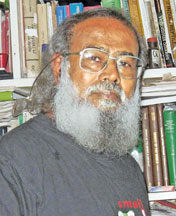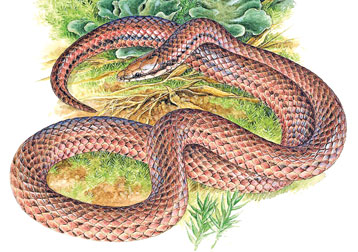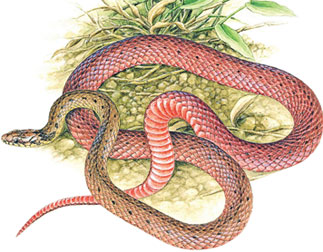|
Snakes:
Fascinating reptiles balance nature
By Dhaneshi YATAWARA
 |
|
Anslem de Silva |
Anslem de Silva is the current Co-Chairman
of the Amphibian Specialists Group Sri Lanka Net Work. He is also the
current Regional Vice Chairman of the Crocodile Specialists Group for
South Asia and Iran. Anslem has published nearly 360 papers on various
aspects of herpetology local and foreign journals including many books.
He has also organized several national and international herpetological
conferences in the country including the Fourth World Congress of
Herpetology, considered the most prestigious herpetological forum in the
world. De Silva over the past five decades has extensively studied
herpetofauna in a variety of ecosystems across the country.
His latest book, Snakes of Sri Lanka: A
coloured Atlas presents 52 full page colour paintings of the snakes of
Sri Lanka that have been drawn using live snakes by the foremost animal
artist in Sri Lanka Jayantha Jinasena.
Highlighting the unique attempt of these two
Sri Lankans, Professor Kraig Adler of the Cornell University USA
commenting on this new work said that a century from now, this folio
atlas will be mentioned together with Patrick Russell's "Indian
Serpents" and Joseph Fayrer's "Thanatophidia of India" as the greatest
works ever produced on the snake fauna of the Indian subcontinent.
Snakes may not be the favourite subject for many of us. Most often it
is a subject that brings fear and uncertainty, thus saving the snakes
whose lives and habitats are threatened, goes unnoticed. Yet one can be
assured that the more you know about this legless carnivorous reptile
world the more you will be fascinated about it. More than the
fascination snakes play a major role in balancing nature. Nearly 2,200
species live in every nook and corner of the world except Antarctica and
a few other islands. All ecological niches of Sri Lanka are practically
a home for this rich and diversified snake fauna.
Relict
 |
|
Common roughside |
Of this rich snake diversity the unique feature would be the relict
species. Why are they called relict species? With reference to the
animal kingdom, relict species means species that were abundant in a
large area but now occurs in a few small areas. According to senior
herpetologist Anslem de Silva, this island nation shelters ten relict
species of snakes that are considered as relict - surviving remnants of
the natural phenomena in animal evolution.
"The ten relict snake species in Sri Lanka is the most interesting
and people rarely know these facts," de Silva said. He has dedicated
over half a century to study and save snakes. According to de Silva the
ten relict species are namely Boie's roughside (Lemedilla), Cope's
roughside (Kalumedilla), Deranaiyagala's roughside (Kandumedilla),
Drummondhay's roughside (ketivalmedilla), Guther's roughside (kudamedilla),
Common roughside (dalavamedilla), Blossom krait (Nihaluva), Ceylon wolf
snake (Dara radanakaya), Black-spined or the Slender mould snake (Kurunkaravala)
and Large Shieldtail (Maha bimulla). These snakes belong to five genera
- Aspidura, Balanophis, Cercaspis, Haplocercus, Pseudotyphlops.
Threats and dangers
The threats faced by relict snakes are loss of habitat, habitat
fragmentation, the heavy application of weedicides, pesticides during
land preparation for agriculture. According to the law, these snakes are
strictly protected under the Fauna and Flora Protection Ordinance of
1993. The CAMP (Conservation Assessment and Management Plan) in several
workshops and reports held worldwide have categorised these snakes as
threatened. The IUCN list also categorises these species as threatened.
They are the indicators of direct human threats to a habitat. Snakes
play important roles in the eco system, as both predators and prey, both
on land and water. Snakes control the rodent population, if left
unchecked, can reach plague proportions and devastate cereal crops.
 |
|
Slender mould snake
|
Snakes like other reptiles have a mechanism to conserve body heat or
to reduce body temperature as required. The snakes become torpid below
40 degrees of Fahrenheit and completely freeze when temperature falls
below 32 degrees of Fahrenheit. The upper temperature limit is the more
critical for snakes. Smaller snakes reach the critical temperature
earlier and quicker than the larger ones. It also depends on the
duration of exposure. Certain species will definitely die if exposed to
hot sun or if over heated in cages.
Destruction of snakes natural habitats can have profound implications
communities. The Department of Wildlife Conservation and the Department
of Forests have declared several wildlife protected areas which play a
large role in the 'in situ' conservation of snakes, as well as other
animals and plants.
Yet, ultimately successful conservation of snakes will largely depend
on wide public awareness. Without good extension work encouraging full
participation of local people in implementing and maintaining
conservation plans there will be little prospects in Sri Lankan snake
conservation.
*********
Rough-sides
As Anslem de Silva explained, out of the ten relict species of
snakes, six are of the Aspidura genus, better known as rough-sides. It
is the commonest snake in Horton Plains.
Explaining the features of rough-sides de Silva said that one may
find ten colour variations among these snakes. Taking 'dalavamedilla' or
the common roughside (Aspidura trachyprocta) as an example de Silva
explained that the Common roughside a nocturnal small snake has a
roundly pointed snout, a cylindrical body and a short tail, which can
grow up to about 300mm in length. It feeds mainly on earthworms and
grubs. Common roughsides lay eggs under decaying logs, rubble heaps and
leaf litter or in loose soil.
 |
|
Ceylon Wolf snake |
According to the researchers roughsides are commonly found in
Ambewela, Hakgala, Horton Plains, Lindula, Nuwara Eliya, Pattipola.
According to an early research done in 1982 by Gans and Fetcho
considered roughsides as a widely distributed form in the central hills,
750m above sea level. It is the commonest snake of the Horton Plains.
The other endemic relict species of snakes belonging to roughsides
other than the common roughside are Aspidura copei(Cope's roughside,
Kalumadilla), Aspidura deraniyagalae (Deranaiyagala's roughside,
Kandumedilla), Aspidura drummondhayi (Drummondhay's roughside,
Ketivalmedilla), Aspidura guentheri(Guther's roughside, Kudamedilla) and
Boie's roughside (Lemedilla).
Blossom krait
Albert Gunther, one of the most recognised researchers of early days,
who brought Nihaluva or the blossom krait (Balanophis ceylonensis ), to
the notice of the scientific world in 1858. Nihaluva can grow up to 400
mm in length. Its head is distinct from neck. Body is cylindrical and
elongated. Scales are strongly keeled. As de Silva explains gut analysis
of this snake have shown a partially digested frog. During the day they
hide under leaf litter or under decaying logs.
De Silva, in one of his researches done in 1969 recorded the museum
collection localities as Kuruvita and Kegalle. Several other researchers
have mentioned Balangoda, Udagama, Peradeniya, Punagala Estate in
Yatiyantota, Lenock estate in the Uva Patnas and one from Balangoda,
Pelmadulla and Bandarawela.
Slender Mould snake
The Kurun karavala (Rath karavala) or the slender mould snake (Black-spined
snake) is a nocturnal snake. The head of the Black-spined snake is long
and the snout broadly rounded. The neck is not distinct. The body is
slender, long and cylindrical and the tail is short. Its average length
is about 350 mm.It lives in damp soil, silted up drains, beneath heaps
of decaying leaves and similar places where there are earthworms.
It's inoffensice and requires dark, wet situations and in some tea
estates, it is found under refuse heaps close to the workers
quarters.The slender mould snake feeds mainly on earthworms. It produces
about three to five eggs.
Researchers have found the slender mould to be common in Gampola,
Knuckles, Kotagala, Medamahanuwara, Pussellawa and Rangala. Early
researches dated back even in 1921 reported the snake seen at Hopewell
Estate, Balangoda, Pundaluoya, and Ramboda and researches in 1955
reported observations in Namunukula and Mousakanda. In some tea estates,
it is found under garbage heaps close to the workers quarters. The
localities of the specimens at the Colombo National Museum are from
Gammaduwa and Kotmale.
Yet de Silva's search in January 2001 in localities where the snake
had been common earlier, not a single specimen could be located, as the
area had been cleared for plantations.
Ceylon Wolf snake
Dara Radanakaya (Cercaspis carinatus) is the Ceylon wolf snake. Dara
Radanakaya, a black snake with distinct white rings is a voracious
feeder, and mainly feeds on geckos, skinks and even other small
non-venomous snakes widely found in rain forests. "I have observed wild
and captive ones feeding on a variety of small snakes with the same
eagerness as for Geckoes," de Silva explained.
The longest found among the wolf snakes was 620 mm. This is a
nocturnal snake, secretive in nature, during the day it hides under fall
leaves, logs and under rubble in forests.
It is found in and around rain forests. During the day they conceal
themselves under heaps of decaying leaves, logs, in drains, crevices in
trees, under stones, in rat holes, sometimes near home-steads.
It is observed that Cercaspis is fond of water or moist places. Even
the captive ones were observed very often immerse themselves in water.
"I have observed this snake from Kahawatte (common), Galle, and Kandy,"
de Silva said. Certain other specimens have been collected were from
Galle, Pundaluoya, Ratnapura, Matugama. CAMP Report list Kahawatte,
Balangoda, Matale, Kandy, Singharaja forest and also state in many
fragmented localities it had been observed. It is present in some
protected areas such as Udawattakele, Kandy and Sinharaja forest.
Shieldtail
Pseudotyphlops philippinus or the Maha Bimmulla (large shieldtail)
can grow in to 300mm in length. It is mostly found in Namunukula,
Kirinda, Kimbulketiya, Palapathwela, Matale. And a CAMP (Conservation
Assessment and Management Plan) workshop held in November 1998 showed
that using informal field sighting and literature records this snake to
be Endangered according to 1994 IUCN Red List criteria.
|

